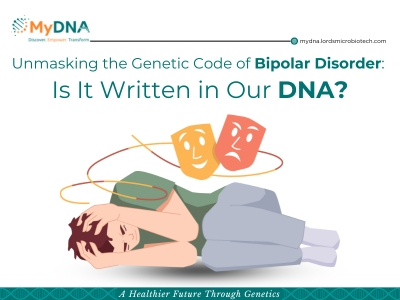
Bipolar disorder, characterised by its distinct mood swings between mania and depression, affects 46 million globally. Bipolar disorder often emerges during adolescence and early adulthood. However, symptoms can appear much earlier, sometimes in childhood. It has long been recognized as a complex interplay between genetic predisposition and environmental factors.
Lack of Self-Awareness:
During manic episodes, individuals may lack insight into their own behaviour. They might feel invincible, make impulsive decisions, or engage in risky activities without fully understanding the consequences.
Stigma and Misconceptions:
There's a lot of misunderstanding surrounding bipolar disorder. People often confuse it with moodiness or simply being "dramatic." This can make it difficult for individuals with the condition to seek help or feel validated.
Family History : The Intertwined Threads
Family history paints a clear picture: individuals with a close relative diagnosed with bipolar disorder have a significantly higher risk of developing the condition themselves. This suggests a strong genetic influence. However, understanding it is not as simple as a single gene mutation. Bipolar disorder is considered a polygenic condition, meaning multiple genes, each with small effects, contribute to the overall risk.
Genes on the Radar:
Genetic advancement have helped identify several genes associated with bipolar disorder, including:
- ANK3: Mutations in this gene have been linked to bipolar disorder, with possible implications for brain development and function.
- PALB2 : The specific SNP associated with bipolar disorder might alter the function of the PALB2 protein, potentially impacting these critical cellular processes. This altered function could be related to the development of bipolar disorder.
- LAMP3 : LAMP3, or lysosomal-associated membrane protein 3, plays a role in cellular processes. Research suggests it to be involved in cell death (apoptosis).
- DGKH : DGKH has also been identified as the strongest Panic Disorder associated gene. It has also been associated with altered brain activity in regions involved in mood regulation, potentially contributing to the development of bipolar disorder.
Beyond the Genes: The Environmental Trigger
While genetics provide a foundation for susceptibility, environmental factors act as triggers that can push an individual towards developing bipolar disorder. These can include:
- Stressful life events: Traumatic experiences or significant life changes can exacerbate mood imbalances.
- Substance abuse: Drug and alcohol use can worsen symptoms and potentially trigger episodes.
- Early life experiences: Childhood trauma or neglect may increase vulnerability to the disorder.
The Evolving Landscape of Genetic Research:
Understanding the genetic basis of bipolar disorder holds immense potential for the future:
- Improved Diagnosis: Genetic markers could aid in earlier identification of individuals at high risk, allowing for preventative measures or early intervention strategies.
- Personalized Treatment: Tailored treatment approaches based on an individual's genetic profile could lead to more effective management of the condition.
While the path to a definitive cure remains long, unraveling the genetics of bipolar disorder is crucial for advancements in diagnosis, treatment, and ultimately, improving the lives of those affected by this complex mental health condition.